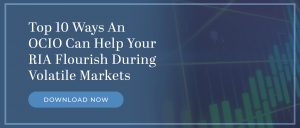One of the main challenges that independent RIAs or IAR firms are grappling with today is delivering competitive rates of return in a volatile market. Between the rise of different investment strategies, an avalanche of data for analyzing investments, and the relentless pressure to deliver competitive returns, it’s placed tremendous demands on the professionals at many financial advisory firms.
Recognizing these realities, there’s been an increasing trend toward outsourcing investment research and portfolio management functions to an OCIO (Outsourced Chief Investment Officer) and TAMP (Turnkey Asset Management Platform).
The question is which alternative is best for your firm?
When you outsource, you’re tapping into a reservoir of highly experienced professionals specializing in investment research, tax-efficient investing strategies, risk management, and portfolio management. These types of expertise aren’t just important; they are crucial because they may define the future success of your firm.
Outsourced investment professionals who have earned the Chartered Financial Analyst (CFA) designation may provide investment insights and strategies far beyond your current capabilities. The result can be a more sophisticated investment process that includes better performance, new asset classes, and reduced risk of big losses.
While large financial firms have in-house CIOs, the emergence of the OCIO model has been a game-changer, particularly for independent RIAs that do not employ full-time CIOs. The fractional OCIO model offers firms a highly personalized investment management service at a very affordable cost.
The other alternative is TAMPs which also offer outsourced investment research and portfolio management services for an asset-based fee. So, as the owner of an RIA of IAR, how do you decide which of model will work best for your firm?
OCIO VS. TAMP: Which Outsourcing Strategy Produces The Best Results?
A Comparison of OCIO vs.TAMP Models
It’s important to understand the differences between the OCIO (Outsourced Chief Investment Officer) model and the TAMP (Turnkey Asset Management Platform) model as your outsourcing solution. Each alternative has some unique characteristics that make them stand out.
Think of a TAMP as similar to outsourcing money management to a mutual fund family. Selecting an OCIO is more like outsourcing to a Separate Account Manager.
The OCIO Model:
- The OCIO model offers a fully custom and personalized approach. Think of your OCIO as another team member who can meet with your staff, clients, and prospects to help you win new business and serve your current clients. You compete with bigger firms because your CIO is in-house and ready to help
- With the OCIO model, agility is the name of the game. It allows RIAs to make adjustments on the fly, ensuring investment strategies remain relevant and timely.
- CFA professionals have specialized knowledge to analyze investment alternatives and make informed decisions, fostering client trust.
The TAMP Alternative:
- The TAMP model is an all-in-one solution, providing everything from portfolio management to administrative services, making the investment process seamless.
- The TAMP model supports this vision if you are just starting your firm or have been in business for years. It offers efficiency, allowing firms to scale their operations smoothly without incurring substantial overhead.
- Variety is the spice of the TAMP model. RIAs can tap into an expansive array of investment products and strategies, ensuring clients have a rich menu of options.
Key Considerations for Your RIA
Here’s a closer look at some core factors to keep in mind as you determine who will be your outsourcing partner:
- If you want to retain your current custodian and make minimal operational changes that could impact your clients, an OCIO is a much more flexible model than a TAMP. With a TAMP, you must convert your clients to their platforms (custodian, operations, documentation, etc.), which can be disruptive and cost clients.
- Do you have strong convictions about an investment philosophy that defines your RIA? If so, an OCIO could be the right choice. They can provide a nuanced, personalized touch to your strategies, ensuring they continue to be aligned with your firm’s ethos. Conversely, suppose your firm is seeking a more general, broad-based approach to investment. In that case, a TAMP might be more suitable, as it offers a range of strategies designed for different client characteristics.
- While both models come with their costs, weighing the tangible monetary costs against the intangible value of improved results is essential. TAMPs typically come with a comprehensive fee structure covering multiple services. An OCIO might have a more specific cost related to their expertise and service offerings. Ensure you clearly understand what you are paying and what you and your clients receive in return.
- An OCIO can give you that close-knit collaboration if you want to continue to be involved with day-to-day investment decisions. They can also be a strategic partner, crafting customized strategies that include your vision. In contrast, TAMPs offer a more hands-off approach, allowing RIAs to delegate most investment tasks while focusing on other core business activities.
When making this important decision, ensure you are focused on your firm’s future and which service (OCIO or TAMP) will produce the best outcomes. OCIOs and TAMPs offer distinct advantages, so this decision is about finding the right long-term fit for your RIA.
Connect with the Cornerstone Portfolio Research team today to learn more about our customized OCIO services for RIAs and IARs.


